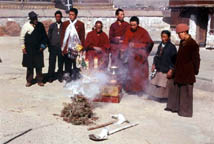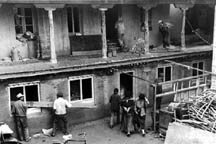|
From The 1999 Annual Report:
 |
|
Merunyingba monks bless
THF working tools |
Initially, restoration of monasteries was not planned by THF because of the enormous needs of the historic residential buildings. With the overall situation in the old town markedly improved, and a growing number of requests from monastic communities, THF had reasons to reconsider. When the Religious Affairs Department and other departments agreed to granting official permission, work on the site which is at the centre of the THF Oedepug Conservation Area began. Merunyingba monastery was founded in the 9th century by the Tibetan king Ralpachen. In the 17th century, the Fifth Dalai Lama made it into the Lhasa seat of the important Nechung State Oracle. During the 1960s, the monastery was closed, chapels converted into stables, and monks' quarters into public housing. Murals were painted over. After 1985, parts of the complex re-opened for religious services. The main building belongs to Nechung which is managed by Drepung monastery, a smaller chapel on the eastern side is managed by Merusarba monastery, and a third chapel is maintained by the Gongkar Choede Sakya-pas. The Merunyingba monks had earlier restored their assembly hall, and uncovered and retouched its murals. Other monastic rooms were left unrestored.
|

|
|
work on the courtyard
galleries |
Years of decay and neglect had taken their effect on the site, and THF had to carry out extensive structural repairs. The Arga roof was renewed, and the traditional red frieze of bundled twigs (pembé) that marks a monastery or government edifice was repaired. A solar-heated shower was installed. A new chapel has been opened on the top floor, and more original paintings were uncovered. A new mural showing the Fifth Dalai Lama and his entourage was painted by Tsewang Dorje, one of the disciples of the acknowledged old master Amdo Jampa. Traditional mineral colours were used, and more new murals are planned. The lay residential housing was rehabilitated and upgraded, and two new toilet systems and new electricity lines have been installed. Funding totaling $ 42,105 was provided by the German Embassy Beijing, from the special budget for cultural preservation. Parts of these funds went into activities in Gorashar ($1,573 for toilet upgrading and courtyard improvements) and Kagyenub ($1,989 for structural stabilization). Further funds for workshops, training activities and bringing in of specialised skills at the Merunyingba worksite were provided by Trace Foundation ($31,341) and Ford Foundation ($2,960), including a newly-trained Arga team, electric installations, metal work and the building of a new prayer-wheel in traditional style for which two old experts were invited.
|

|
|
celebration of the completion
of the Merunyingba Project |
The German-Embassy-funded restoration was complimented by the upgrading of two toilet systems for the lay residents, and building of one system for the monks, as well as providing the monks with a solar-heated shower facility. Total costs: $3,034
On January 21, the head of the Cultural Affairs Section of the German Embassy, Mr. Holger Green, attended a small
celebration in Merunyingba.
|